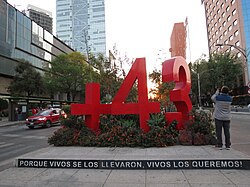
Missing persons cases are a major problem in Mexico, which are often linked to criminal organizations or being in the wrong place at the wrong time.
According to Mexico’s National Registry of Missing and Unlocated Persons (RNPDNO), there are about 118,000 active cases of disappearances, but that number may not be entirely reliable, considering the number of cases that go unreported due to fear or lack of trust in the government. A large number of the missing persons cases in general are from 2007 onwards, which coincides with the rise of more unpredictable and militarized cartels.
Comparing the number of cases in Mexico to the United States, there are over 25,000 open missing persons cases in the U.S., according to the National Missing and Unidentified Persons Systems (NamUs). This means Mexico has more than four times as many active missing persons cases as the U.S.
Estefani Tovar, a 25-year-old secondary school teacher from the outskirts of the city of Celaya, has had a couple of students who have had a parent disappear. “The mother of one of my students disappeared two years ago. It left him broken, and he doesn’t trust people anymore because there wasn’t much done to find her. It’s a lamentable situation, and it made it difficult for him to learn,” Tovar said.
Tovar continues, “An important point is how much people lose hope because of these cases and how much they don’t believe in good people anymore. Kids are left without parents and are put in a vulnerable position. Meanwhile, we don’t know what institutions are supposed to handle all of these cases.”
A common trend is the distrust of police officers when looking for missing persons in Mexico. Some people think they don’t do anything, or they think the officers are in on it due to corruption.
Mayra B., a 24-year-old dental assistant from Celaya, is not fond of how the police handle missing persons cases. “A person is supposed to be considered missing after 72 hours, and even after that, they (the police) don’t go out to look. They don’t show you that they’re doing anything at all. They’re very insignificant in that aspect,” she says.
A notorious case that fueled the distrust of public officials was in 2014, when 43 students who attended Ayotzinapa Rural Teachers’ College disappeared, inciting massive outrage and a huge cover-up by the Mexican government. The local police, military, and a local cartel were allegedly involved. What happened to a majority of the students is still unknown.
Maribel A., a 52-year-old originally from the state of Tamaulipas, says, “Sometimes people are kidnapped to be put to work for criminal groups, and the police don’t do anything because they’re certainly in the same line of work.”
“When my daughter was in high school, she walked out one day after school and saw people in a truck threatening a group of other students. A young man from the group was taken right in front of her. He was only a little bit younger than her.”
Maribel continues, “She came home crying and frantic. She was so scared, and to this day, we don’t know what happened to him. We don’t know whether he was forced to join a criminal group or if he was murdered.”
Across Mexico, there are groups, most notably the Madres Buscadoras (Searching Mothers), dedicated to finding missing persons. Although many of the people in these groups have lost hope that they would find their loved ones alive, finding the bodies gives them the closure they desperately need after going through that insurmountable pain.
Both Mayra and Tovar said one of the first things they would do if a loved one went missing is contact one of the dedicated search groups and spread the news through social media.
One of Mayra’s cousins disappeared, and she detailed how scared she was due to his alleged involvement in the drug business and the state he was found in. “He got involved in drugs, and one day, one of his sisters reported him missing. There was nothing for four months, until his body was found with the head chopped off,” she said.
“A lot of the time, you don’t know what to wait for, if the person is already, or if you should have that hope that they’re still alive. It’s very complicated, and it’s hard to know where to look. Then there are the rumors, no matter if they’re innocent or not, people will always say that they were involved with drugs,” Mayra said.
Tovar suggested that the Mexican government needs to work with the families, not just to help with finding the missing, but also to help them deal with the emotions associated with losing someone in that manner. “The government needs to find a way to keep us safe. Not only that, there should be social organizations to help families and kids deal with what they’re going through. It all starts with education,” she says.
As of May 2025, RNPDNO has already reported almost 12,000 missing persons cases, with about half of them being active cases. These are clear signs that the cases are not slowing down and that the Mexican government will continue to have its hands full with these missing persons cases.

